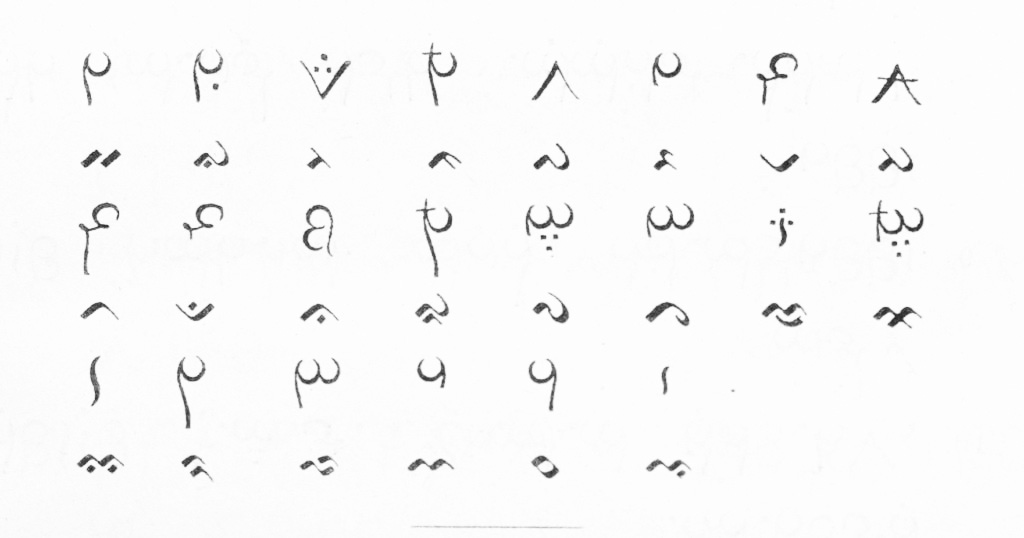In a sense, every script is a code, comprehensible to some, incomprehensible to those who don’t know its workings. The Lontara Bilang-Bilang script, though is a deliberate interweaving of the Lontara script of Sulawesi and an ancient Arabic number-substitution code, and it has been used for both poetry and espionage.
Christopher Ray Miller writes: “This script is derived from an Arabic “abjad” cipher [that] takes as its basis the numeric values of the Arabic letters in their old order similar to Phoenician, Aramaic and Hebrew. Each letter in the cipher is replaced by the corresponding Hindu-Arabic numeral, which stops above the baseline for 1-9, touches the baseline from 10 to 99, crosses the baseline for 100 to 999, and crosses with an added curl below for 1000 and up.” In other words, you see a number and convert it to a letter.
The region has a long history of literature à clef, with entire novels being written in various ciphers. The bilang-bilang cipher is more commonly used in word games and poetry, according to Wikipedia:
“Lontara script has a traditional ciphered version called Lontara Bilang-bilang, which is sometimes used specifically to write basa to bakke’ ᨅᨔ ᨈᨚ ᨅᨀᨙ, a kind of word game, and élong maliung bettuanna ᨕᨙᨒᨚ ᨆᨒᨗᨕᨘ ᨅᨛᨈᨘᨕᨊ, riddles that utilizes basa to bakke’. In élong maliung bettuanna, audience are asked to figure the correct pronunciation of a seemingly meaningless poem. When given in the form of Lontara text, the riddle giver would read the text in one way and audience may guess alternative readings of the same text to reveal the poem’s hidden message.”
The extraordinary story of bilang-bilang and its relationship with the Bugis people and their script, however, cannot be told without the story of Colliq Pujie, whose role in Bugis literature is even greater than that of any single figure in English — a fact that is all the more remarkable for her being a woman.
Colliq Pujié (or, to give her her full name, Retna Kencana Colliq Pujié Arung Pancana Toa Matinroé ri Tucaé) was the daughter of La Rumpang, King of the Kingdom of Tanete, now the Barru Regency in South Sulawesi. Born in 1812, she grew up at a time when her island was still struggling against the Dutch to achieve autonomy. Her father entrusted her not only with an education but with the running of royal affairs.
She did so with a possibly unique feat of linguistic subversiveness: in order to communicate in secret with others in the Bugis resistance, she began incorporating bilang-bilang characters into the Bugis script.
Bilang-bilang–the term means “numbers,” specifically Arabic numbers–was an importation of one of the secret shorthand scripts used by Muslim travelers or the Gujarati merchants of northeast India, which had spread along trade routes into South Asia, Southeast Asia, and Indonesia. Because these characters were numbers, which were not only incomprehensible to the Dutch but appeared to have no meaning when embedded in a text, they had a fascinating hidden-in-plain-sight quality, and became woven into the Bugis-Makasar script.
Linguist, historian, classicist, resistance fighter, editor, poet, diplomat, she eventually died in the process of writing out and editing La Galigo, the great 6,000-page, twelve-volume epic poem of Bugis literature, one of the longest epics in the world. The text, by the way, is not merely an epic or mythic poem, but each volume is thought to contain the spirits of the characters: before it is open and read aloud, it must be preceded by ritual that may include the burning of incense, and the sacrifice of a chicken or goat.

4.4364° S, 119.6499° E